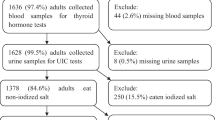Abstract
Objective: The association between iodine status and the prevalence of goiter and thyroid nodules has been well established but the extent to which different iodine intake levels influence the incidence of goiter and thyroid nodules is unclear. The aim of the study was to determine the incidence of goiter and thyroid nodules in 3 regions with different iodine intake levels: mildly deficient, more than adequate, and excessive. Design, patients and measurements: Of the 3385 un-selected subjects enrolled in 1999 in Panshan, Zhangwu, and Huanghua where median urinary iodine excretion (UIE) was 83.5 μg/l, 242.9 μg/l, and 650.9 μg/l, respectively, 2708 (80.0%) participated in the follow-up study in 2004. The examinations of thyroid ultrasonography, thyroid function, thyroid autoantibodies and UIE were performed at baseline and follow-up. Results: The cumulative incidence of diffuse goiter was 7.1 %, 4.4%, and 6.9%, respectively, higher in Panshan and Huanghua than in Zhangwu (p=0.013 and p=0.015) and that of nodular goiter was 5.0%, 2.4%, and 0.8%, respectively, declining with increasing iodine intake levels (p<0.001). Mild iodine deficiency, chronic iodine excess as well as positive thyroid autoantibodies were associated with the occurrence of goiter [Logistic regression: odds ratio (OR)=1.83 (95% confidence interval (CI) 1.26–2.65), OR=1.46 (95% CI 1.01–2.11 ) and OR=1.68 (95% CI 1.14–2.48), respectively]. The cumulative incidence of single nodule was 4.0%, 5.7%, and 5.6%, respectively and that of multiple nodules was 0.4%, 1.2%, and 1.0%, respectively. Conclusions: The relationship between iodine and the risk for the occurrence of diffuse goiter shows a U-shaped curve. Nodular goiters are more prevalent in iodine-deficient areas.
Similar content being viewed by others
References
Knobel M, Medeiros-Neto G. Iodine Deficiency Disorders. In: DeGroot LJ, Jameson JL (eds). Endocrinology, 5th ed. Philadelphia: Elsevier Saunders. 2006, 2129–45.
Fountoulakis S, Philippou G, Tsatsoulis A. The role of iodine in the evolution of thyroid disease in Greece: from endemic goiter to thyroid autoimmunity. Hormones (Athens) 2007, 6: 25–35.
Zimmermann MB, Ito Y, Hess SY, Fujieda K, Molinari L. High thyroid volume in children with excess dietary iodine intakes. Am J Clin Nutr 2005, 81: 840–4.
Bournaud C, Orgiazzi JJ. Iodine excess and thyroid autoimmunity. J Endocrinol Invest 2003, 26(2 Suppl): 49–56.
Hu F, Teng X, Teng W, et al. A comparative epidemic study of goiter and thyroid nodules in areas with different iodine intake. Chin J Endemiology 2002, 21: 464–7.
Teng W, Shan Z, Teng X, et al. Effect of iodine intake on thyroid diseases in China. N Engl J Med 2006, 354: 2783–93.
Brunn J, Block U, Ruf G, Bos I, Kunze WP, Scriba PC. Volumetrieder schilddruesenlappen mittels real-time-sonographie. Dtsch Med Wochenschr 1981, 106: 1338–40.
Dunn JT, Crutchfield HE, Gutekunst R, Dunn AD. Methods for measuring iodine in urine. Wageningen, the Netherlands: International Council for the Control of Iodine Deficiency Disorders, 1993.
Delange FM. Control of iodine deficiency in Western and Central Europe. Cent Eur J Public Health 2003, 11: 120–3.
Laurberg P. Prevention in endocrinology. In: Wass J, Shalet S (eds). Oxford Textbook of Endocrinology and Diabetes. Oxford University Press, 2001.
Wang WB, Jin Y, Teng WP, et al. Comparative epidemiological study on serum TSH levels of normal population in three communities with different iodine intakes. Chin J Endocrinol Metab. 2002, 18(5): 355–6.
Vanderpump MP, Tunbridge WM, French JM, et al. The incidence of thyroid disorders in the community: a twenty-year follow-up of the Whickham Survey. Clin Endocrinol (Oxf) 1995, 43: 55–68.
Author information
Authors and Affiliations
Corresponding author
Rights and permissions
About this article
Cite this article
Yu, X., Fan, C., Shan, Z. et al. A five-year follow-up study of goiter and thyroid nodules in three regions with different iodine intakes in China. J Endocrinol Invest 31, 243–250 (2008). https://doi.org/10.1007/BF03345597
Accepted:
Published:
Issue Date:
DOI: https://doi.org/10.1007/BF03345597



